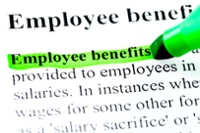
by admin | Apr 26, 2017 | ACA, Benefit Management
 A Summary of Benefits and Coverage (SBC) is four page (double-sided) communication required by the federal government. It must contain specific information, in a specific order, and with a minimum size type, about a group health benefit’s coverage and limitations. If an employer providing an SBC is a covered entity under the Section 1557 of the Patient Protection and Affordable Care Act (ACA), additional requirements apply.
A Summary of Benefits and Coverage (SBC) is four page (double-sided) communication required by the federal government. It must contain specific information, in a specific order, and with a minimum size type, about a group health benefit’s coverage and limitations. If an employer providing an SBC is a covered entity under the Section 1557 of the Patient Protection and Affordable Care Act (ACA), additional requirements apply.
On April 6, 2016, the Centers for Medicare and Medicaid Services (CMS), the Department of Labor (DOL), and the Department of the Treasury issued the final 2017 summary of benefits and coverage (SBC) template, group and individual market SBC instructions, uniform glossary of coverage and medical terms, a coverage example calculator, and calculator instructions.
The SBC is to be used by all health plans, including individual, small group, and large group; insured and self-funded; grandfathered, transitional, and ACA compliant. The new SBC must be used for plan years with open enrollment periods beginning after April 1, 2017. It will not be used for marketplace plans for the 2017 coverage year.
For fully insured plans, the insurer is responsible for providing the SBC to the plan administrator (usually this is the employer). The plan administrator and the insurer are both responsible for providing the SBC to participants, although only one of them actually has to do this.
For self-funded plans, the plan administrator is responsible for providing the SBC to participants. Assistance may be available from the plan administrator’s TPA, advisor, etc., but the plan administrator is ultimately responsible. (The plan administrator is generally the employer, not the claims administrator.)
Changes
The template includes a new “important question” that asks “Are there services covered before you meet your deductible?” and requires family plans to disclose whether or not the plan has embedded deductibles or out-of-pocket limits. This is reported in the “Why This Matters” column in relation to the question “what is the overall deductible?” and plans must list “If you have other family members on the policy, they have to meet their own individual deductible until the overall family deductible has been met” or alternatively, “If you have other family members on the policy, the overall family deductible must be met before the plan begins to pay.”
Tiered networks must be disclosed and the question “Will you pay less if you use a network provider?” is now included. The SBC also includes language that warns participants that they could receive out-of-network providers while they are in an in-network facility. The SBC also indicates that a consumer could receive a “balance bill” from an out-of-network provider.
The “explanatory coverage page” was dropped from the template.
The coverage examples provided clarify the “having a baby” example and the “managing type 2 diabetes” example, in addition to providing a third example of “dealing with a simple fracture.” The coverage example must be calculated assuming that a participant does not earn wellness credits or participate in an employer’s wellness program. If the employer has a wellness program that could reduce the employee’s costs, the employer must include the following language: “These numbers assume the patient does not participate in the plan’s wellness program. If you participate in the plan’s wellness program, you may be able to reduce your costs. For more information about the wellness program, please contact: [insert].”
The column for “Limitations, Exceptions, & Other Important Information” must contain core limitations, which include:
- When a service category or a substantial portion of a service category is excluded from coverage (that is, the column should indicate “brand name drugs excluded” in health benefit plans that only cover generic drugs);
- When cost sharing for covered in-network services does not count toward the out-of-pocket limit;
- Limits on the number of visits or on specific dollar amounts payable under the health benefit plan; and
- When prior authorization is required for services.
The template and instructions indicate that qualified health plans (those certified and sold on the Marketplace) that cover excepted abortions (such as those in cases of rape or incest, or when a mother’s life is at stake) and plans that cover non-excepted abortion services must list “abortion” in the covered services box. Plans that exclude abortion must list it in the “excluded services” box, and plans that cover only excepted abortions must list in the “excluded services” box as “abortion (except in cases of rape, incest, or when the life of the mother is endangered).” Health plans that are not qualified health plans are not required to disclose abortion coverage, but they may do so if they wish.
By Danielle Capilla, Originally Published By United Benefits Advisors

by admin | Apr 21, 2017 | ACA, Human Resources
 One might describe the series of events leading to the death of the American Health Care Act (Congress’s bill to repeal and replace the Affordable Care Act) as something like a ballistic missile exploding at launch. The Patient Protection and Affordable Care Act (ACA) repeal debate began nearly a decade ago with former President Barack Obama’s first day in office and reemerged as a serious topic during the 2016 presidential election. Even following the retraction of the House bill, repeal of the ACA remains a possibility as the politicians consider alternatives to the recent bill. The possibility of pending legislation has caused some clients to question the need to complete their obligation for ACA reporting on a timely basis this year. The legislative process has produced a great deal of uncertainty which is one thing employers do not like, especially during the busy year end.
One might describe the series of events leading to the death of the American Health Care Act (Congress’s bill to repeal and replace the Affordable Care Act) as something like a ballistic missile exploding at launch. The Patient Protection and Affordable Care Act (ACA) repeal debate began nearly a decade ago with former President Barack Obama’s first day in office and reemerged as a serious topic during the 2016 presidential election. Even following the retraction of the House bill, repeal of the ACA remains a possibility as the politicians consider alternatives to the recent bill. The possibility of pending legislation has caused some clients to question the need to complete their obligation for ACA reporting on a timely basis this year. The legislative process has produced a great deal of uncertainty which is one thing employers do not like, especially during the busy year end.
While the “repeal and replace” activity is continuing, it is imperative that employers and their brokers put their noses to the grindstone to fulfill all required reporting requirements. To accomplish this, employers will need brokers that can effectively guide them through this tumultuous season. We recommend that employers ask their brokers about their strategies for
- Implementing the employer shared responsibility reporting
- Sending all necessary forms to the employer’s employees
- Submitting the employer’s reporting to the IRS
- Closing out the employer’s 2016 filing season
Employers should also inquire about any additional support that the broker provides. They should provide many of the services that we at Health Cost Manager provide to our clients: They should apprise their clients of the latest legislative updates through regular email communication and informational webinars. Brokers should also bring in experts in the field that have interacted with key stakeholders in Washington. And most important, they should remain available during this uncertain period to answer any questions or concerns from clients.
We know employers would prefer not to have to comply with these reporting obligations – many have directly told us so. We understand this requires additional work on their part to gather information for the reporting and increased compliance responsibility. Knowing how stressful the reporting season can be for employers, brokers should go out of their way to help their clients feel confident that they can steer through the reporting process smoothly. The broker’s role should be to take as much of the burden off the employer’s shoulders as possible to enable them to reach compliance in the most expedient manner possible. Sometimes this involves stepping in to solve data or other technical issues, or answering a compliance-related question that helps the client make important decisions. It’s all part of helping employers navigate through the ACA’s strong headwinds during these uncertain times.
By Michael Weiskirch, Originally Published By United Benefit Advisors

by admin | Mar 24, 2017 | ACA, Group Benefit Plans, IRS
 A fixed indemnity health plan pays a specific amount of cash for certain health-related events (for example, $40 per office visit or $100 per hospital day). The amount paid is neither related to the medical expense incurred, nor coordinated with other health coverage. Further, a fixed indemnity health plan is considered an “excepted benefit.”
A fixed indemnity health plan pays a specific amount of cash for certain health-related events (for example, $40 per office visit or $100 per hospital day). The amount paid is neither related to the medical expense incurred, nor coordinated with other health coverage. Further, a fixed indemnity health plan is considered an “excepted benefit.”
Under HIPAA, fixed dollar indemnity policies are excepted benefits if they are offered as “independent, non-coordinated benefits.” Under the Patient Protection and Affordable Care Act (ACA), excepted benefits are not subject to the ACA’s health insurance requirements or prohibitions (for example, annual and lifetime dollar limits, out-of-pocket limits, requiring individual and small-group policies to cover ten essential health benefits, etc.). This means that excepted benefit policies can exclude preexisting conditions, can have dollar limits, and do not legally have to guarantee renewal when the coverage is cancelled.
Further, under the ACA, excepted benefits are not minimum essential coverage so a large employer cannot comply with its employer shared responsibility obligations by offering only fixed indemnity coverage to its full-time employees.
Some examples of fixed indemnity health plans are AFLAC or similar coverage, or cancer insurance policies.
Recently, the IRS released a Memorandum on the tax treatment of benefits paid by fixed indemnity health plans that addresses two questions:
- Are payments to an employee under an employer-provided fixed indemnity health plan excludible from the employee’s income under Internal Revenue Code §105?
- Are payments to an employee under an employer-provided fixed indemnity health plan excludible from the employee’s income under Internal Revenue Code §105 if the payments are made by salary reduction through a §125 cafeteria plan?
By Danielle Capilla, Originally Published By United Benefit Advisors

by admin | Mar 15, 2017 | ACA, Benefit Plan Tips, Tricks and Traps, COBRA, Compliance, Medicare
 Our Firm is making a big push to provide compliance assessments for our clients and using them as a marketing tool with prospects. Since the U.S. Department of Labor (DOL) began its Health Benefits Security Project in October 2012, there has been increased scrutiny. While none of our clients have been audited yet, we expect it is only a matter of time and we want to make sure they are prepared.
Our Firm is making a big push to provide compliance assessments for our clients and using them as a marketing tool with prospects. Since the U.S. Department of Labor (DOL) began its Health Benefits Security Project in October 2012, there has been increased scrutiny. While none of our clients have been audited yet, we expect it is only a matter of time and we want to make sure they are prepared.
We knew most fully insured groups did not have a Summary Plan Description (SPD) for their health and welfare plans, but we have been surprised by some of the other things that were missing. Here are the top five compliance surprises we found.
- COBRA Initial Notice. The initial notice is a core piece of compliance with the Consolidated Omnibus Budget and Reconciliation Act (COBRA) and we have been very surprised by how many clients are not distributing this notice. Our clients using a third-party administrator (TPA), or self-administering COBRA, are doing a good job of sending out the required letters after qualifying events. However, we have found that many clients are not distributing the required COBRA initial notice to new enrollees. The DOL has recently updated the COBRA model notices with expiration dates of December 31, 2019. We are trying to get our clients to update their notices and, if they haven’t consistently distributed the initial notice to all participants, to send it out to everyone now and document how it was sent and to whom.
- Prescription Drug Plan Reporting to CMS. To comply with the Medicare Prescription Drug Improvement and Modernization Act, passed in 2003, employer groups offering prescription benefits to Medicare-eligible individuals need to take two actions each year. The first is an annual report on the Centers for Medicare & Medicaid Services (CMS) website regarding whether the prescription drug plan offered by the group is creditable or non-creditable. The second is distributing a notice annually to Medicare-eligible plan members prior to the October 15 beginning of Medicare open enrollment, disclosing whether the prescription coverage is creditable or non-creditable. We have found that the vast majority (but not 100 percent) of our clients are complying with the second requirement by annually distributing notices to employees. Many clients are not complying with the first requirement and do not go to the CMS website annually to update their information. The annual notice on the CMS website must be made within:
- 60 days after the beginning of the plan year,
- 30 days after the termination of the prescription drug plan, or
- 30 days after any change in the creditability status of the prescription drug plan.
- ACA Notice of Exchange Rights. The Patient Protection and Affordable Care Act (ACA) required that, starting in September 2013, all employers subject to the Fair Labor Standards Act (FLSA) distribute written notices to all employees regarding the state exchanges, eligibility for coverage through the employer, and whether the coverage was qualifying coverage. This notice was to be given to all employees at that time and to all new hires within 14 days of their date of hire. We have found many groups have not included this notice in the information they routinely give to new hires. The DOL has acknowledged that there are no penalties for not distributing the notice, but since it is so easy to comply, why take the chance in case of an audit?
- USERRA Notices. The Uniformed Services Employment and Reemployment Rights Act (USERRA) protects the job rights of individuals who voluntarily or involuntarily leave employment for military service or service in the National Disaster Medical System. USERRA also prohibits employers from discriminating against past and present members of the uniformed services. Employers are required to provide a notice of the rights, benefits and obligations under USERRA. Many employers meet the obligation by posting the DOL’s “Your Rights Under USERRA” poster, or including text in their employee handbook. However, even though USERRA has been around since 1994, we are finding many employers are not providing this information.
- Section 79. Internal Revenue Code Section 79 provides regulations for the taxation of employer-provided life insurance. This code has been around since 1964, and while there have been some changes, the basics have been in place for many years. Despite the length of time it has been in place, we have found a number of groups that are not calculating the imputed income. In essence, if an employer provides more than $50,000 in life insurance, then the employee should be paying tax on the excess coverage based on the IRS’s age rated table 2-2. With many employers outsourcing their payroll or using software programs for payroll, calculating the imputed income usually only takes a couple of mouse clicks. However, we have been surprised by how many employers are not complying with this part of the Internal Revenue Code, and are therefore putting their employees’ beneficiaries at risk.
There have been other surprises through this process, but these are a few of the more striking examples. The feedback we received from our compliance assessments has been overwhelmingly positive. Groups don’t always like to change their processes, but they do appreciate knowing what needs to be done.
By Bob Bentley, Originally Published By United Benefit Advisors

by admin | Mar 9, 2017 | ACA, COBRA, Compliance, Human Resources, IRS
 The Internal Revenue Service (IRS) recently updated its longstanding Questions and Answers about Information Reporting by Employers on Form 1094-C and Form 1095-C that provides information on:
The Internal Revenue Service (IRS) recently updated its longstanding Questions and Answers about Information Reporting by Employers on Form 1094-C and Form 1095-C that provides information on:
Generally, the Q&A describes when and how an employer reports its offers of coverage and describes the codes that employers should use when completing Form 1094-C and Form 1095-C for calendar year 2016 that are to be filed in 2017. The Q&A should be used in conjunction with the Instructions for Forms 1094-C and 1095-C which provide detailed information about completing the forms.
The updated Q&A provides information on COBRA reporting that had been left pending in earlier versions of the Q&A for the past year. UBA’s ACA Advisor “IRS Q&A About Employer Information Reporting on Form 1094-C and Form 1095-C” reviews the new information and explains other reporting obligations covered under the Q&A.
Reporting Offers of COBRA Continuation Coverage
An offer of COBRA continuation coverage that is made to a former employee due to termination of employment is not reported as an offer of coverage in Part II of Form 1095-C.
If the applicable large employer is required to complete a Form 1095-C for the former employee (because, for example, the individual was a full-time employee for one or more months of the year before terminating employment), the employer should use code 1H, No offer of coverage, on line 14 for any month that the former employee was offered COBRA continuation coverage. For those same months, the employer should use code 2A, Employee not employed during the month, on line 16 for each month in which the individual is not an employee (regardless of whether the former employee enrolled in the COBRA continuation coverage).
An employer that provides COBRA continuation coverage through a self-funded health plan generally must report that coverage for any former employee or family member who enrolls in that COBRA continuation coverage in Part III of the Form 1095-C. Also, the employer may report the coverage on Form 1095-B for any individual who was not an employee during the year and who separately elected the COBRA continuation coverage.
By Danielle Capilla, Originally Published United Benefit Advisors

by admin | Mar 2, 2017 | ACA, Group Benefit Plans, Human Resources
 Last fall, President Barack Obama signed the Protecting Affordable Coverage for Employees Act (PACE), which preserved the historical definition of small employer to mean an employer that employs 1 to 50 employees. Prior to this newly signed legislation, the Patient Protection and Affordable Care Act (ACA) was set to expand the definition of a small employer to include companies with 51 to 100 employees (mid-size segment) beginning January 1, 2016.
Last fall, President Barack Obama signed the Protecting Affordable Coverage for Employees Act (PACE), which preserved the historical definition of small employer to mean an employer that employs 1 to 50 employees. Prior to this newly signed legislation, the Patient Protection and Affordable Care Act (ACA) was set to expand the definition of a small employer to include companies with 51 to 100 employees (mid-size segment) beginning January 1, 2016.
If not for PACE, the mid-size segment would have become subject to the ACA provisions that impact small employers. Included in these provisions is a mandate that requires coverage for essential health benefits (not to be confused with minimum essential coverage, which the ACA requires of applicable large employers) and a requirement that small group plans provide coverage levels that equate to specific actuarial values. The original intent of expanding the definition of small group plans was to lower premium costs and to increase mandated benefits to a larger portion of the population.
The lower cost theory was based on the premise that broadening the risk pool of covered individuals within the small group market would spread the costs over a larger population, thereby reducing premiums to all. However, after further scrutiny and comments, there was concern that the expanded definition would actually increase premium costs to the mid-size segment because they would now be subject to community rating insurance standards. This shift to small group plans might also encourage mid-size groups to leave the fully insured market by self-insuring – a move that could actually negate the intended benefits of the expanded definition.
Another issue with the ACA’s expanded definition of small group plans was that it would have resulted in a double standard for the mid-size segment. Not only would they be subject to the small group coverage requirements, but they would also be subject to the large employer mandate because they would meet the ACA’s definition of an applicable large employer.
Note: Although this bill preserves the traditional definition of a small employer, it does allow states to expand the definition to include organizations with 51 to 100 employees, if so desired.
By Vicki Randall, Originally Published By United Benefit Advisors

 A Summary of Benefits and Coverage (SBC) is four page (double-sided) communication required by the federal government. It must contain specific information, in a specific order, and with a minimum size type, about a group health benefit’s coverage and limitations. If an employer providing an SBC is a covered entity under the Section 1557 of the Patient Protection and Affordable Care Act (ACA), additional requirements apply.
A Summary of Benefits and Coverage (SBC) is four page (double-sided) communication required by the federal government. It must contain specific information, in a specific order, and with a minimum size type, about a group health benefit’s coverage and limitations. If an employer providing an SBC is a covered entity under the Section 1557 of the Patient Protection and Affordable Care Act (ACA), additional requirements apply.




